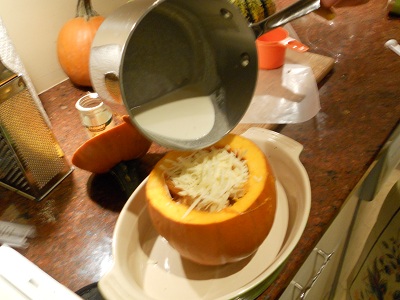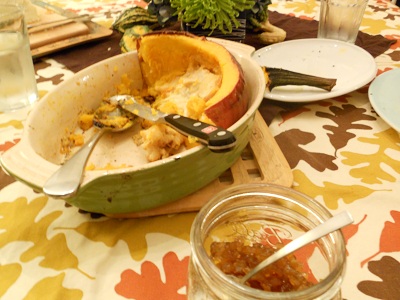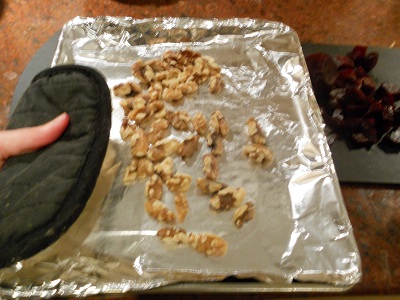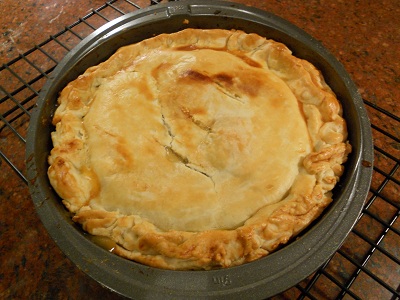
In July, as I was savoring peaches whose juices dripped down my wrist and fresh corn on the cob that required a good flossing after munching, I started wishing it was October. It was in July that I found a recipe in Melissa Clark’s In the Kitchen with A Good Appetite for a pumpkin whose empty shell had been thoughtfully stuffed with alternating layers of toasted baguette, Gruyère, and a sauce of heavy cream and white wine steeped with sage and nutmeg. “I found this recipe,” I would say to Rich, my sister, friends, the cat – really, anyone in ear shot — “that is going to be off the chain. Off. The. Chain.”
for a pumpkin whose empty shell had been thoughtfully stuffed with alternating layers of toasted baguette, Gruyère, and a sauce of heavy cream and white wine steeped with sage and nutmeg. “I found this recipe,” I would say to Rich, my sister, friends, the cat – really, anyone in ear shot — “that is going to be off the chain. Off. The. Chain.”
Well, it’s finally October, which means some of the best foods of the whole year – butternut squash, beets, arugula, cauliflower and, wait for it, pumpkins – have started to appear at markets and in CSA boxes around town. Two weeks ago, my weekly CSA list noted an inclusion of a sugar pumpkin, which meant I was this close to fulfilling my stuffed pumpkin dream.

When I arrived at the student union for my usual Thursday pick up, there was a new girl checking off names. It was obvious there was no pumpkin in my box, and, even more frustrating, there was an enormous pile of sugar pumpkins on display right next to her. Rather than putting her on the spot, I thanked her for my pumpkinless box and brought it back to my office. Naturally, the only thing to do was call the farm and see how I could go about getting my rightful pumpkin at the next week’s pickup. They were totally cool about it; apparently I was the only person who either did not get their promised pumpkin – or who was crazy enough to actually call them about it. “There’s a pumpkin shortage this year!” I tried to explain to Rich.
Well, this week I received my promised pumpkin, as well as a new pumpkin in my box. So now, I can either make this dish twice, or use the second one for a terrific pumpkin pudding recipe I stumbled upon last year around this time.
Friday night we finally had the pumpkin of my dreams. It was everything I hoped it would be: the perfect combination of softened sweet squash mixed with the savory notes of the cheese, cream and sage. It may have been one of the best things I’ve ever eaten, and I eat a lot. Our dinner guest thought the pumpkin tasted like pumpkin pizza, minus the sauce. He suggested rather than me choosing between making this recipe a second time or making the pumpkin pudding, that I should go and find more pumpkins and make this again and again. Like I said: Off. The. Chain.

Given the cost of the Gruyère, I wouldn’t break the bank on a good one. Trader Joe’s carries reasonably priced cheeses. We’re not really big wine drinkers; lucky for us, the liquor store now carries teensy little bottles of wine. Mine cost $1.99, and I am pretty sure I can get three more pumpkins out of it. My point is: don’t break out the good stuff for this dish. We’re lucky enough to have a sage bush growing in front of our house; please feel free to stop by and pluck some leaves if that’s the only thing stopping you from making this dish.

Cheesy Baked Pumpkin with Gruyère Fondue from Melissa Clark’s In the Kitchen with A Good Appetite
I think I’m a little late to the Melissa Clark fan club, as she has written and co-written dozens of cookbooks. In the Kitchen is how I imagine a good cookbook to be: excellent writing and tales followed by superb recipes. I had this book for less than five hours when I decided that we needed to have the baked flounder and eggs for dinner that night. Clark actually suggests it as a breakfast, which sounds amazing to me. And I’ve made her green goddess dressing three days in a row. She has a new book out this week, and I cannot wait to get my hands on it.
Ingredients
6 (1-inch) slices baguette
½ cup heavy cream
½ cup dry white wine
¼ cup milk
1 large garlic clove, peeled and smashed
3 fresh sage leaves
½ teaspoon freshly ground black pepper
1 (3-4 pound) sugar pumpkin, well-scrubbed
5 ounces grated Gruyère cheese (1 ¼ cups)
1 Tablespoon extra-virgin olive oil
Directions
• Preheat oven to 425. Cut the baguette slices in half lengthwise and place on a baking sheet. Bake until golden brown, 5 to 7 minutes.
• In a medium saucepan, bring the cream, wine, milk, garlic, and sage to a boil over medium heat. Reduce the heat to low and allow to simmer for 5 minutes. Take the mixture off the heat and discard the garlic and sage. Stir in ½ teaspoon of salt, the nutmeg, and the pepper.
• Cut the top off the pumpkin and scoop out the pulp and seeds. (If you want to toast your own pumpkin seeds, and I always do, see the Note below.) Set the pumpkin in a baking dish. Place a layer of bread in the bottom, followed by a layer of the cheese. Poor in a third of the cream mixture. Repeat for 2 more layers and replace the pumpkin lid. Using your fingers, rub the oil all over the outside of the pumpkin and sprinkle on additional salt.
• Bake the pumpkin until the skin blisters and the flesh is fork-tender, about 1 ¼ hours. Allow to cool in the pan slightly, then slice to serve.
NOTE: I saw this method for toasting squash seeds on Jody Adams and her husband’s new blog The Garum Factory. Like everything Jody does involving food, it’s pretty much perfect.
BONUS TOASTED PUMPKIN SEEDS RECIPE FROM THE GARUM FACTORY: Put the mass of pumpkin pulp and seeds in a large bowl and fill it three-quarters full with water. Work the pulp with your fingers to release the seeds from the fibers. The seeds will float. Skim the seeds and spread them on a sheet pan. Bake in the oven for 3-4 minutes or until dry. Remove the tray from the oven, drizzle a Tablespoon of oil over them, then season with salt, smoked paprika and a pinch of sugar. Smear everything about, then return the pan to the oven. Roast until the seeds are golden brown and crisp, about 8 more minutes. Use as a garnish, or eat like popcorn with a great beer.

Bonus Cat Photo































